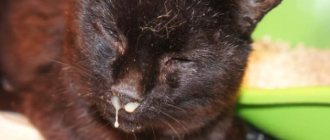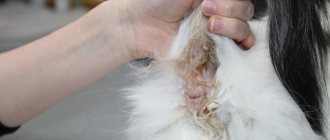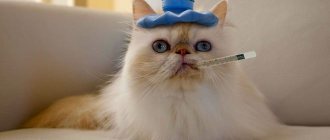A pregnant cat's discharge often appears right before giving birth. If secretions leak from the genitals 5-6 weeks before the kittens are born, you should seek help from a veterinarian, as this is a symptom of inflammation.
The secretion that appeared immediately before childbirth is completely safe and indicates the beginning of the mucous plug from the cervix. This phenomenon is observed approximately three days before the birth of babies.
Read about how to find out if your cat is pregnant here.
Why is discharge dangerous for a pregnant cat?
The average length of pregnancy in cats is 9 weeks. The following stages are distinguished:
| Duration in weeks | Stage |
| 3 | early |
| 6 | embryo formation |
| 9 | prenatal |
The first and last stages are the most severe. With average, the animal remains energetic, the babies at this time are only gaining height and moving little by little. At this stage, the cat should not normally have any discharge. Although in some cases this is acceptable.
The problem is the pet’s excessive cleanliness. Since cats carefully wash themselves, the owner may not pay attention to the appearance of unwanted discharge.
In the early stages of pregnancy, a light pink discharge often appears. The eggs are immersed in the uterus and are fixed there, as a result of which a small amount of secretion is released.
At 4 weeks, the uterus closes and transparent and watery mucous formations form. It is very difficult to notice them, since they pass away along with the urine.
Subsequently, before the onset of 6 weeks, the presence of discharge indicates physiological disorders.
Small transparent or yellowish watery discharge may appear as the uterus fills with water, squeezing excess fluid out. If small clots are found that do not bother the pet, there is no need to panic and worry the cat in vain. But in other situations, it is necessary to seek help from a veterinarian, especially if discharge of purulent formations is noticed.
By the end of pregnancy, the appearance of discharge is normal. Rejection of the mucous membrane indicates the onset of labor. This means that the first baby has begun to move. As a rule, a pregnant woman develops lumps of a yellowish or greenish color.
Also read the article about how long a cat walks while pregnant.
General information
Let’s immediately deal with one important nuance. There is discharge during pregnancy, and there is immediate prenatal discharge. If your cat has any “leaking” from the external genitalia, and there is still a month left before giving birth, immediately take your pet to the veterinarian. Discharge during such a period is an unambiguous pathology, indicating the presence of inflammatory processes in the organs of the cat’s reproductive system.
Discharge that appears shortly before birth does not pose any danger. It is very likely that your pet is simply losing a mucus plug from the cervix. This can happen about three days before giving birth. If mucous discharge appears much earlier than this period, you should contact a veterinarian. Early removal of the plug does not bode well for either the cat or her offspring.
Mucus plug, what is it and what is it for?
Any animal lover who has experienced childbirth in their pets at least once probably knows about the existence of the cervix. This is the tubular part of the organ, the function of which can be compared with the intestinal sphincters, for example. In the normal state (when the cat is not pregnant), the cervix is always tightly closed due to contraction of muscle tissue. This reliably prevents pathogenic and conditionally pathogenic microflora from entering the organ cavity.
The uterus must always and in all cases remain sterile! Everything else is a deviation from the norm.
At the time of birth, a certain number of microbes may enter the organ cavity, but, as a rule, the body is able to cope with them on its own.
True, there is one nuance. During pregnancy, the cervix is no longer closed so tightly. This is due to the fact that subsequently the organ will still have to relax, since otherwise the cat will not be able to give birth. It is at this time that the mucous plug acquires special significance: it serves as a “plug” that does not allow dirt and microorganisms into the organ cavity.
Cork is impenetrable to air and other environmental factors. Damage to it during pregnancy is always fraught with a number of extremely unpleasant consequences. In cases where the integrity of the “plug” is broken in the last three to five days before birth (brown mucus), nothing bad will happen. This is a completely physiological phenomenon, and it poses no danger either to the cat itself or to its offspring.
But in situations where the plug is damaged long before childbirth, this does not bode well: pathogenic and conditionally pathogenic microflora, dirt and other negative environmental factors enter the cavity of the pregnant uterus. All this leads to the development of severe inflammatory processes.
Signs of mucous plug coming off before childbirth
If the cat is fairly clean and regularly licks the genital area (and right before giving birth, she does this all the time), then you may not notice anything. But the classic signs of a mucous plug coming off is the appearance of mucous discharge from the external genitalia . Normally they are pink, but may have a reddish-pinkish or even brown color. Let us emphasize once again that this is a completely normal phenomenon, and it does not pose any danger to the health and life of the animal.
But with normal prenatal discharge, the animal’s behavior should also remain normal. Since the animal senses the approaching birth, it becomes restless and constantly runs around the house in search of the most suitable place for kittens.
If something is wrong, the cat may meow “hysterically,” avoid contact with the owner, and react inadequately to attempts to palpate its stomach. If such signs appear, you should immediately contact a veterinarian.
Mr. Cat Explains: Safe Slime Formations
The appearance of pink discharge may be noted after mating, this is normal.
You should carefully observe the abundance of mucous formations; if a foreign odor develops or blood is separated, you need to seek help from a veterinary hospital.
Until the cervix closes completely, unfertilized eggs can be seen leaving the genitals in the form of a brown discharge. This is considered the norm, as it indicates the mummification of dead, decomposing embryos, which occurs with complete sterility in the womb. If an organ is infected, an inflammatory process begins.
Pregnancy periods and “dangerous” periods
A cat's pregnancy lasts 9 weeks and is divided into three periods. The calmest stage is the middle stage of pregnancy from 3 to 6 weeks, the cat sleeps, eats and purrs, the kittens grow at this time and begin to make their first movements. In general, discharge during pregnancy is not normal, but is allowed for a number of reasons. The difficulty is that cats are usually very clean and lick the loop, but the owner simply does not notice the discharge.
From 0 to 3 weeks, the eggs descend into the uterus and become implanted; the process may be accompanied by slight light pink discharge. At 2-3 weeks, the cervix closes with a mucus plug, excess mucus can come out - watery, transparent, viscous. Most often, discharge comes out during urination and is difficult to notice.
From 3 to 6 weeks there should be no discharge. In rare cases, clear or white discharge appears, sometimes with a yellow tint. The period coincides with a noticeable “rounding” of the abdomen - the uterus expands and fills with amniotic fluid, squeezing the excess out.
By week 9, the cat begins to actively prepare for childbirth. A pregnant cat's discharge may appear 20 to 24 hours before giving birth. Rejection of the mucus plug signals the beginning of labor - the first kitten has begun to move along the birth canal. If you notice mucous discharge or a “lump” with a greenish or yellow tint, get ready; in 6–8 hours a newborn will appear in your house. After the start of active contractions and pushing, translucent yellow discharge appears, which is replaced by brown or bloody discharge.
Important! The cat maintains the cleanliness of the external genital organs - this is inherent in nature, and visual observation of discharge is considered a deviation from the norm. If your pet has matted fur under its tail or there is too much discharge from the genital tract, take the animal to the veterinarian; the reluctance to “wash” may be due to weakness, intoxication, or pain.
Prevention
To ensure your cat’s pregnancy goes smoothly, prevention is important:
- Monitor the cat’s well-being, get vaccinations (to prevent infection), and monitor the correct diet. Regularly take the animal to the veterinary hospital for examination.
- With the onset of pregnancy, carefully monitor the cat’s behavior, mood and appearance.
- Follow medical recommendations.
- Protect the cat from hypothermia, excessive humidity and wind.
We also recommend an article about whether a cat can be sterilized during pregnancy.
Treatment of white discharge
If your cat has a white or yellow discharge, this should be a good reason to contact a veterinary clinic. Do not hesitate, because time can play against your pet. The doctor must immediately take tests, swabs and conduct all studies, assess the situation with his eyes and with the help of ultrasound. This will help you understand why your cat has white discharge.
The prescribed treatment is often complex. In especially severe cases, surgical intervention is allowed.
It is worth understanding that the recovery process will be a huge stress for the animal and may take more than one day or even a month. Therefore, it is during this period that the cat will need the care and support of the owner. A combination of love and medication should help the animal cope with inflammatory processes.
- home
- >
- Cats
- >
- Cat health
- >
- What does bleeding in a pregnant cat mean?
Preventive measures
Some discharge is a variant of a normal physiological process. To avoid the addition of pathological flora and subsequent inflammation, you need to follow a number of recommendations:
- strictly observe antiseptic conditions during childbirth;
- regular health checks with a veterinarian;
- Ultrasound of the uterus should be done periodically;
- when mating, carefully check the cat for the absence of genitourinary infections;
- do not postpone a visit to a specialist if you notice a different cat behavior with a specific secretion and smell.
Cat pregnancy is a process during which it is worth paying close attention to your pet. Unhealthy discharge in a pregnant cat is a reason to immediately contact a veterinarian. Timely treatment will help maintain the health of the pet and the life of the kittens in the womb.
Video
Many cat owners, even if they have at least some experience, are afraid of their pet giving birth. You can often hear that the process of giving birth to babies almost certainly must be accompanied by some complications and difficulties. Fortunately, this is far from the case, and it is rarely necessary to really help the animal. Other breeders are concerned about discharge before childbirth: they also believe that discharge from the external genitalia must necessarily indicate something unpleasant and deadly... Is this really so, is it necessary to immediately contact a veterinarian?
Diagnostics
Diagnosing cat diseases is not difficult, since veterinary medicine has a wide variety of diagnostic techniques. Laboratory diagnostic methods are especially informative.
Most often, vaginal discharge is examined. A smear or scraping is taken. The obtained materials are examined by various laboratory methods (microscopy, cultural culture, etc.). Cultural culture allows not only to determine the type of bacteria, but also to select the most suitable antibiotic.
They also take blood for analysis. The study is carried out in different ways, depending on what disease is suspected. The most popular methods: ELISA, PCR.
In order to detect malignant neoplasms, ultrasound or X-ray examination with a contrast agent is used. In difficult cases, an MRI may be prescribed. But such a study can only be done in large veterinary clinics.
Endometritis
Purulent discharge from the uterus in a cat should always alert the owner. Sometimes the cause of such processes in the animal’s body is endometritis, which can manifest itself in two forms. The first form is chronic, in which it is usually impossible to detect the disease in a timely manner, since the cat behaves quite normally.
The acute form of this disease negatively affects the condition of the animal; it does not show any interest in the surrounding world. With this disease, a four-legged friend not only shows apathy, but also lacks appetite. If you do not consult a doctor with this form of the disease, the cat may die.
Vaginal discharge in a dog
Pets require careful care and attention from their owners. When deciding to buy a four-legged friend, you need to remember that this is a great responsibility and the health of the animal depends largely on the owner. Any pathological deviations from the dog’s standard behavior or incomprehensible symptoms are a reason to contact a veterinarian and promptly find out the reasons for their appearance and eliminate them.
Types of vaginal discharge in dogs
If you have a pet, you need to closely monitor its health and learn to distinguish natural processes in the body from pathological phenomena that lead to various dog diseases. Vaginal discharge in an animal can be of various types, but in most cases it is a cause for concern for its owner.
Normal natural discharge is a consequence of physiological processes in the dog’s body. Their appearance is noted during estrus, before childbirth or in the postpartum period. These discharges are distinguished from pathological ones by the fact that they do not have a strong unpleasant odor. Mostly transparent, but a small amount of blood is allowed.
Discharges that signal the appearance of some kind of disease are of a completely different nature. They are called pathological, that is, they differ significantly from normal ones. Most likely, unnatural inflammatory processes have begun in the genitals of the pet. These discharges can be different, most often purulent. Yellow-green, brown, bloody, cloudy and with a foul odor - dangerous to the health, and sometimes even the life of the animal, and require prompt medical intervention.
If unnatural discharge is detected, you should immediately contact a veterinarian. Self-diagnosis and treatment are not always successful. A dog may be sick with a number of dangerous diseases and
Source











